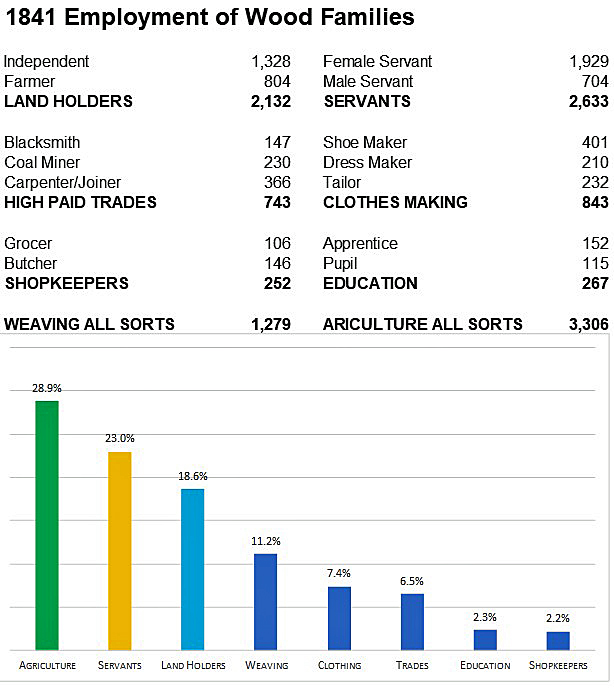
 Finding out the occupation of an ancestor is a strategy that provides research guidance and can prove relationships. Sons, especially before 1800, tended to adopt the trades
of their fathers and uncles. For example, the butchers of a certain village with the Wood surname are often members of the same family. Trades are particularly
useful if a village has two Wood families with overlapping dates and events. A trade can be used to group records into households, even if the trade of only one family is known. In this way, researching a line
that is not your family can identify your ancestors.
Finding out the occupation of an ancestor is a strategy that provides research guidance and can prove relationships. Sons, especially before 1800, tended to adopt the trades
of their fathers and uncles. For example, the butchers of a certain village with the Wood surname are often members of the same family. Trades are particularly
useful if a village has two Wood families with overlapping dates and events. A trade can be used to group records into households, even if the trade of only one family is known. In this way, researching a line
that is not your family can identify your ancestors.
Between 1700 and 1840, almost 20% of the Wood families of Essex were land holders, just over 20% were servants in large households, and 16% were tradesmen and shopkepers. Therefore, more than 50% of the Wood Famlies of Essex can be found in Land Records, Estate Accounts, and newspaper articles advertising goods and services.

Before the 19th century, economic activity was based in agriculture. Learning the economic patterns of agriculture gives insight into the standard of living. Between 1264 and 1710 the per ton price of wheat rose from £385 to £1,000. Between 1711 and 1855 the per ton of wheat hovered around £800, although with the ups and downs year over year that still characterize agricultural markets. Between 1801 and 1895 the price of wheat dropped from £897 to £379 (Forecasting Methods and Applications. Makridakis et al, Wiley, 1997).
Between 1700 and 1850 was a good period for landowners and famers. During the first half of the 19th century the wages of agricultural workers increased. The simple explanation is that agricultural profits were fat, and the labor pool was in competition with the emerging manufacturing sector. Pre 1800, 74% of the work force was in agriculture (Alle, RC, The British Industrial Revolution, p. 17). By 1820 the labor participation rate in agriculture dropped to 35.4%, and then declined to 11.2% in 1911. (The Occupational Structure of England and Wales, c.1750-1911, the INCHOS workshop held in Cambridge July 29th-31st 2009 by Leigh Shaw-Taylor).
Weaving was an important industry in Essex. Flemish refugees fleeing persecution in The Netherlands, introduced a type of coarse woolen cloth called “bays and says,” which increased productivity but also eventually depressed the market. “In 1570 about 200 Flemish refugees settled in Colchester,” bringing with them “the production of serge cloths known as bays and says [which was manufactured at Colchester], and then also at Coggeshall, Bocking, Braintree, Halstead, Dedham, [followed by] …Witham, Kelvedon, and Dunmow” (Essex PH Reaney MA, County History Reprints, SR Publishers Limited, p 81). Bay cloth is woolen cloth with a coarse nap. Colchester and Bocking were famous for producing this cloth, with a reputation for high quality. In about 1660 the wool trade declined due to market forces, and Parliament to stimulate the weaving industry passed Acts requiring the use of woolen burial shrouds. Weaving continued to be a major industry in Essex through the 17th and 18th centuries. In 1841, 11.2% of Essex’s workforce was still employed in the weaving industry.
We do not know what you know. Please share with us your knowledge, and help us correct any error you find in our research.